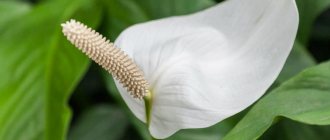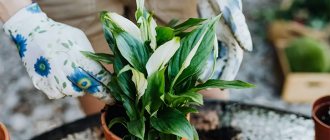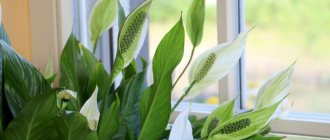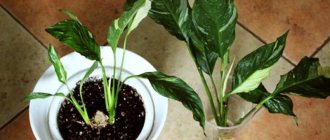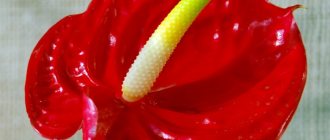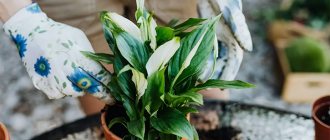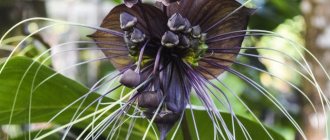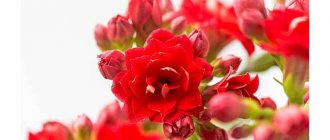Spathiphyllum (popularly known as “Women’s Happiness”) is a plant of the Araceae family. This exotic flower takes root well in apartments and offices and is easy to care for.
Dear readers! For you, we have created communities on social networks in which useful articles and interesting ideas are published several times a day! Subscribe and receive useful content in a convenient format!
The flower has large shiny leaves of rich green color and white inflorescences on a long stem.
In the wild it grows in the South American tropics and on the Philippine islands.
Caring for Women's Happiness after Purchase
For spathiphyllum to grow and bloom, it is necessary to create the right conditions and provide appropriate care. “Women's Happiness” loves lighted places or partial shade, room temperature and high humidity. It does not tolerate direct exposure to ultraviolet radiation and drafts.
Spathiphyllum feels best near eastern or western windows.
IMPORTANT! Having bought a flower in a store, it must be quarantined so that it gets used to its new microclimate. This will also protect other plants from possible infection by diseases and parasites.
Do I need to replant after purchase?
In the store, flowers are sold in small pots made of cheap thin plastic. This is done to save money. Moreover, sometimes instead of nutritious soil in stores, the flower grows in a special transport substrate. After watering, it thickens and stops allowing air to pass through to the roots. Because of this, they gradually begin to rot.
Thus, replanting a plant after purchasing and maintaining quarantine is necessary and is part of caring for women’s happiness.
First, you will inspect the root system of the flower. This will help identify diseases.
Secondly, spathiphyllum will grow in new nutrient soil. In this case, the soil will be loose enough so that the water does not stagnate in it and the roots do not rot.
Thirdly, you can choose the right size pot for the flower. This will further stimulate its growth.
Rules for choosing indoor plants
When choosing a houseplant, you should not focus solely on the appearance of the flower. An equally important role is played by what properties a culture has. For example, there are plants that attract prosperity, love, and profit into the house. And there are those who, on the contrary, will push away everything positive from housing. This is why it is so important to know which flowers should be grown on your windowsill.
Houseplants have special properties
To increase the beneficial effects of a plant that brings love and happiness to your home, you need to follow simple recommendations:
- Follow the basic rules of crop care. In order for the plant to cope with its task, it is important to provide it with all the conditions for normal growth and development. Basic care procedures include: regular moderate watering, fertilizing, loosening the soil and wiping the leaves from dust.
- Talk to culture. Yes, yes, you heard right, the flower must “hear” that you love it. Tell him how beautiful he is - the result will not take long to arrive.
- Find the right place. For example, if the gardener is waiting for his soulmate, the pot should be placed on the south-eastern window sill. This way the plant will attract love.
- In the matter of attracting love and family happiness, a huge role is played by who gave the flower. Ideally, it should be someone very close.
Growing conditions and care features
Today, about five dozen varieties of spathiphyllum are known. About half is used for decorative purposes, and about 10 are suitable for home and office use.
Caring for spathiphyllum at home briefly:
- Lighting : bright, diffused. When located on the south side, shading is required.
- Temperature : +21+23 degrees Celsius.
- Humidity : high. Regular humidification from a spray bottle or an automatic humidifier is required.
- Location : ideally - eastern window sill. Place it on the south side in the back of the room.
- Feeding : 1-2 times a month. During the dormant period, do not feed.
- Watering : as the soil dries out. Do not allow water to stagnate in the pot.
- Transplant . The young plant is replanted annually. Then - once every 2-4 years.
- Reproduction : dividing the bush during transplantation or cuttings.
- Dormant period : October - February.
- Other : protect from drafts, select a pot according to size, regularly prune after flowering.
Spathiphyllum is unpretentious in care and growing conditions. It is able to grow even in a dark corner at low temperatures. Of course, in this case the plant gets sick more often and looks inconspicuous, with small leaves and pale flowers.
To achieve beautiful flowering of spathiphyllum, it needs to create the most comfortable home conditions.
Lighting at home
For proper care and growth, spathiphyllum must be provided with the necessary amount of light. But, at the same time, “Women’s Happiness” does not tolerate exposure to direct rays of the sun. Therefore, if you place a plant on the south side, it must be shaded.
Spathiphyllum can also develop in partial shade. But you should be careful here; poor lighting makes the leaves of the plant small. The inflorescences become pale and quickly fall off.
Temperature
Spathiphyllum loves warmth. The ideal temperature is about 23 degrees. Spathiphyllum is a hardy flower and can grow in both lower and higher temperatures. However, you should not subject the plant to tests, as the flower will begin to hurt.
Air humidity
Like a true resident of the tropics, spathiphyllum loves a humid climate. Therefore, if your apartment is dry, then you need to spray it with a spray bottle. During the summer months, it is advisable to do this in the morning and evening.
In addition, it is recommended to place a container with wet expanded clay or pebbles next to the pot.
You need to especially carefully monitor air humidity in winter and summer. During the cold season, heating devices operate to dry the air. In summer it is very hot, and moisture evaporates quickly in the sun.
Choosing a place to put the flower
Spathiphyllum must be protected from the harmful effects of the sun. If your windows face south, then it is best to place the plant in the back of the room. The best place for this exotic plant is near the eastern window. There the flower will have light, but it will not get sunburned.
What does a houseplant look like in the interior?
Spathiphyllum will add color to the interior of your room or office. At the same time, the flower does not look pretentious or vulgar.
The plant looks very beautiful on a light or, conversely, very dark background.
Some people prefer to place spathiphyllum in the bedroom at the head of the bed. Also popular is placement on low pedestals.
Tall varieties are placed directly on the floor.
You can also decorate the flower by placing containers with wet pebbles or decorative moss next to it.
Why do spathiphyllum buds turn black, yellow or dry?
| Characteristic signs | Root Causes |
| dry, brown discoloration | burns from fertilizers or sun |
| yellowing leaves and flowers | there is little moisture, the soil is depleted, the lower leaves are dying, the air is dry |
| wet black spots, limp leaves | excess moisture, fungal infections, thrips, spider mites, musty air, old substrate, drafts and hypothermia |
Blooming spathiphyllum is a reward and gratitude for painstaking work and care. If the plant does not produce flower stalks, it needs to be given a little attention. And then the decorative bush will present elegant, refined flowers-sails.
Popular varieties of “Women’s happiness”
Chopin
Spathiphyllum Chopin
This plant variety is the result of selection. Chopin has a small height (about 35-40 cm) and is easy to care for. It has elongated leaf blades with clearly visible veins. The aroma is pleasant, but not cloying.
Vivaldi
Spathiphyllum Vivaldi
This variety is distinguished by a cream-colored inflorescence located on a high stalk. The leaves, unlike the Chopin variety, are more oval. The central vein is clearly visible. The rhizome is shortened.
Sensation
Spathiphyllum Sensation
Hybrid is distinguished by its high growth. With proper care, spathiphyllum “Sensation” can grow up to 150 cm. It has proportionate, large and expressive inflorescences.
Wallis
Spathiphyllum Wallis
This variety is considered the founder of many other varieties of spathiphyllum. It is not too tall, about 30-45 cm. The size of the inflorescence is about 3-5 cm. Among all varieties, it is considered the hardiest and most suitable for growing at home, one of the most unpretentious varieties to care for.
Cannofolia
Cannoleaf spathiphyllum
This variety is often used for breeding and is rarely found at home. The inflorescence is yellowish, the leaf blades are rich in color.
Verdi
Spathiphyllum Verdi
Variety Verdi grows up to 70 – 75 cm in height. It is distinguished by its snow-white inflorescence. Among all varieties of spathiphyllum, it requires special care conditions and is the most light- and heat-loving. The optimal temperature for growing is 25 - 27 degrees.
Domino
Spathiphyllum Domino
This hybrid blooms longer than others, with proper care. It also looks more advantageous thanks to the neat leaves, pointed at the end. It differs in appearance due to the randomly located stripes on the leaf plates. This feature gave the variety its name.
Picasso
Spathiphyllum Picasso
This variety is similar in appearance to "Domino", but the white stripes on its leaves are more often located. Moreover, some leaf blades are colorless. It is the result of breeding work with the “Wallis” variety.
Description
Spathiphyllum, a member of the Araceae family, is native to the tropical forests of Central and South America and some regions of Southeast Asia. The main species are distributed in Brazil, Colombia, Guyana, Trinidad, Venezuela, and the Philippines. A characteristic feature of the plant is a pearly white leaf with a yellowish cob-shaped inflorescence in the center.
Spathiphyllum in the tropics
The large leaves have a rich dark green color and shine. The central stripe and side veins stand out noticeably on them. They reach up to 20 cm in size and are located on long petioles.
Bloom
If the Spathiphyllum is doing well but not perfectly, it will produce a lot of new leaves but will not bloom. When, with good care, flowering does not occur throughout the year, you should think about a new place for the plant; the previous one may be too dark, despite the diffused light. The Russian sun simply does not have the power of the tropical. In addition, the architectural features of the building (small windows, etc.) may have an effect.
Important! Weak morning sun will not cause leaf burns, so it is possible to place the spathiphyllum flower in direct sunlight in the morning. This sometimes solves the problem.
Flower type and shape
What appears to be a large flower petal on the spathiphyllum is actually not one. This is a modified leaf, a bract, which acquires a white color during maturity. Over time, the bract turns slightly green. In different types of spathiphyllum, it may differ slightly in shape: be more elongated, spoon-shaped, curled in the shape of a cone, etc. The inflorescence is a central cob of yellowish tones.
Spathiphyllum flower
Caring for the plant during the flowering period is characterized by an active regime of watering and fertilizing.
Conditions for flowering, or how to care for it to bloom
The flowering of spathiphyllum depends on the care conditions that are provided to it.
- Correct pot size. If the container is too small, the flower will have nowhere to grow. If it is too large, then the spathiphyllum will not bloom until its roots fill the entire volume.
- No drafts. From drafts, spathiphyllum gets sick and sheds its leaves. Therefore, if you open the windows for ventilation in winter, the plant must be moved to another place at this time.
- Correct temperature conditions. Women's happiness grows well at room temperature. If the thermometer shows less than 16 degrees for a long time, the flower will get sick and die. If, on the contrary, you place it in the scorching sun, the plant will simply “burn out.”
- Lack of nutrition. Spathiphyllum is fed 1-2 times a month. During the dormant period, it is better to stop feeding.
- Timely watering. Women's happiness should be watered as the soil dries out. Under no circumstances should water be allowed to stagnate in the pot. Because of this, the root system of the flower rots.
- Prevention of diseases and pests. Regular inspection of the flower will help prevent the development of fungal diseases and pests. If you do not want your spathiphyllum to disappear, carefully inspect the stems and leaves of the flower at least once every two weeks.
Sources
- Dorozhkina E.A. The influence of plants on the indoor microclimate and the human body // International scientific journal “Symbol of Science”, No. 4, 2015 https://cyberleninka.ru/article/n/vliyanie-rasteniy-na-mikroklimat-pomescheniy-i-organim-cheloveka/
- Plant taxonomy. Spathiphyllum // The Plant List https://www.theplantlist.org/1.1/browse/A/Araceae/Spathiphyllum/
- State catalog of pesticides and agrochemicals approved for use on the territory of the Russian Federation as of July 6, 2022 // Ministry of Agriculture of the Russian Federation https://mcx.gov.ru/ministry/departments/departament-rastenievodstva-mekhanizatsii-khimizatsii- i-zashchity-rasteniy/industry-information/info-gosudarstvennaya-usluga-po-gosudarstvennoy-registratsii-pestitsidov-i-agrokhimikatov/
Flower transplant
There is no need to replant Women's Happiness too often. While the flower is still young and growing, this can be done once a year. When the plant reaches its maturity, the frequency of transplants is reduced to once every 2-4 years.
Most often, spathiphyllum is transplanted using the transshipment method so as not to damage the roots.
But, if your pet is sick or has been in the same soil for too long, then when replanting it is better to clean the roots from the old soil. This method will also allow you to propagate spathiphyllum.
IMPORTANT! When replanting Women's Happiness, be sure to place drainage at the bottom of the pot.
Spathiphyllum transplant
Landing
When planting spathiphyllum, it is very important to choose the right pot size and soil. Women's happiness grows best in a mixture of peat, sand, turf, leaf soil and humus.
Before placing a flower in a new container, it is imperative to inspect the root system. Rotten and damaged roots are removed. Cuts and wounds are treated with a solution of potassium permanganate and sprinkled with crushed activated carbon.
Also, when planting spathiphyllum, it is recommended to trim off old leaves and peduncles. This is done so that the plant takes root better.
Spathiphyllum in the interior
“Women's Happiness” will perfectly complement any interior thanks to its large bright green leaves and unusual flowers.
Varieties that grow up to 1 meter can be planted in special outdoor pots. Small views will decorate any windowsill or any other place. Spathiphyllum is often placed in bedrooms. Many believe that the plant will protect against adultery and ignite passion between spouses.
Reproduction
You can get several new young plants from one spathiphyllum in 3 ways:
- Seeds.
- By dividing the bush during transplantation.
- By cuttings.
The most effective way to propagate this plant is by dividing the bush. When you transplant a flower to a new place, you need to thin out the shoots. This can be done by dividing the rhizome into several parts. This way you will get 2-3 new plants that can be planted in separate pots.
The advantage of this method is that you get ready-made plants with a developed root system.
Reproduction of spathiphyllum
IMPORTANT! When dividing a spathiphyllum bush, be very careful. Be sure to treat damaged roots with potassium permanganate and crushed activated carbon.
How does it bloom at home?
White sail, White leaf is called spathiphyllum due to the characteristic features of a wide, bedspread-like (translated as “bedspread-leaf”), curved and graceful pointed snow-white flower.
The inflorescence-spike is decorative, pubescent, found in yellow, pale pink and cream shades. The basal rosette (bundle of leaves) produces a peduncle stem. The peduncle itself is 1.5-2 times longer than the leaves. The spadix is found sessile or pedunculated, surrounded at the base by a spacious blanket.
The peculiarity is that 2-3 flowers bloom on each bush at the same time , several more flowers gradually spread their covers, over the entire season, as a rule, up to 8-10 buds ripen on an adult healthy spathiphyllum.
Trimming
Spathiphyllum is pruned after flowering has ended. The old peduncle is removed, as well as yellowed or dried leaves of the plant. This procedure is carried out so that nutrients are not consumed on the faded peduncle.
Trimming is carried out with a stationery knife. This way the cut will be neat. By pruning with scissors, you damage the plant tissue, which can lead to infection. Sections must be treated with crushed activated carbon.
Pruning should be done as close to the root as possible.
Rejuvenation
Rejuvenation is important in the process of growing spathiphyllum. The fact is that over time the plant ages and loses its beauty.
The most effective way to rejuvenate a flower is to root a stem with aerial roots. The algorithm of actions is as follows:
- Select a stem with aerial roots.
- Cut the petioles from the stem so as not to damage the aerial roots. Please note that you need to cut off the petioles that are located below the leaf.
- Wrap the stem below the leaf rosette with a plastic sleeve.
- Make several ventilation holes in the sleeve.
- Moisturize periodically.
- After 50-60 days, roots will appear under the film.
- Cut the stem below the sleeve.
- Carefully remove the film so as not to damage the roots and plant the plant in the pot.
There is an easier way - cut off part of the stem with a rosette and place it in water until roots appear. When the roots grow to about 5 cm, the plant can be planted in a permanent place.
Watering
The watering regime for spathiphyllum depends on the time of year. In spring and summer, during the period of growth and abundant flowering, watering should be regular and abundant. In autumn and winter – moderate.
IMPORTANT! At any time of the year, you need to water the plant only when at least the top layer of soil has dried out. Otherwise, the water will begin to stagnate. This will lead to rotting of the root system.
Spathiphyllum should be watered with settled water at room temperature. Ideally, filtration can also be carried out to remove harmful deposits.
The consequences of improper watering and how to combat them
- The accumulation of excess moisture in the substrate can lead to rapid rotting of the roots, the appearance of mold and mildew.
This can be determined by the stem becoming soft, somewhat darkened (in advanced cases, brown), mold grows from the base of the plant over the entire surface of the soil, and dark spots form on the leaves. To eliminate the problem, you need to transplant the spathiphyllum into healthy soil, first cutting off the infected parts of the rhizome and treating the remaining parts with a fungicidal preparation. - Too dry soil causes the plant to wither and the leaves to turn yellow. The situation can be corrected by emergency watering with properly prepared water and spraying to return the plant to its normal state as quickly as possible.
- White spots on the leaves and their dry tips are the consequences of watering spathiphyllum with icy and too hard water mixed with harmful salts. In this case, it is necessary to wash the earthen lump, plant it in a new substrate, wipe the leaves from plaque and not make such a mistake in the future.
Watering, as one of the decisive factors, lies in the success of growing spathiphyllum. If its substrate always contains the required amount of moisture, then it will often delight the eye with its aesthetic appearance. And most importantly, there is nothing difficult in establishing a watering regime.
Top dressing
Feeding Women's happiness is worth it in accordance with the time of year. During the cold season, apply fertilizers no more than once a month, and it is best to refrain from fertilizing at all.
In spring and summer, the amount of fertilizing increases, since more nutrients are consumed during the growth period. Therefore, at this time of year you need to feed the flower once every 2 weeks. This fertilizer application schedule continues until the end of flowering.
Spathiphyllum prefers organic fertilizers, but it perfectly accepts complex mineral fertilizers for flowers in diluted form.
Inflorescence colors
Spathiphyllum has many types and varieties. Many believe that the inflorescence of a flower can be not only white, but also pink, red, green or yellow. But that's not true. The red flower has an anthurium that looks like “female happiness.”
Coloring the inflorescence in different colors is only possible artificially using special dyes. In nature, spathiphyllum is only white. At different flowering periods, some varieties exhibit a light cream or greenish color.
Diseases and pests
Spathiphyllum most often suffers from root rot, sooty fungus and late blight. All these are fungal diseases. They are dangerous because they spread very quickly throughout the plant and lead to its death.
If you notice that the leaves or stems of your pet have begun to turn black, then it is necessary to urgently treat it with a fungicide. In addition, the affected parts of the plant must be cut off and destroyed.
Spathiphyllum falls victim to the following pests:
- aphid;
- spider mite;
- scale insect;
- mealybug.
You can fight insects using insecticidal agents (for example, Fitoverma). You can also use tobacco infusion against aphids and scale insects. It is mixed with a soap solution and the stems and leaves of the plant are thoroughly treated.
To protect the flower from fungal diseases and pests, prevention should be included in the care of spathiphyllum. Preventive actions include: regular inspection of the plant, compliance with care rules, timely treatment with fungicides and insecticides.
It is important to remember that prevention is much easier than fighting for the life of an infected plant.
Sick spathiphyllum
IMPORTANT! If a flower is sick, it must be quarantined. In addition, it is necessary to conduct a preventive inspection of other plants.
How to resuscitate?
If your pet is not blooming, then there is a way to help him. But two conditions must be met:
- The flower should not be sick.
- The plant has not been recently replanted.
To make spathiphyllum bloom, it can be “shocked,” that is, placed in extreme conditions for a while. In an effort to survive, the plant will produce a flower.
To begin with, the pot with Women's Happiness is placed for 15 days in a cool place with a temperature of about 12 degrees.
After 2 weeks, the flower is returned to its usual place and a special liquid supplement (Uniflor-bud or Kemira Lux) or an extract from bird droppings is added.
IMPORTANT! Before purchasing fertilizer, make sure that the percentage of nitrogen in the fertilizer is less than the percentage of phosphorus and potassium.
After some time, the plant “shocked” in this way will begin to bloom. At this time, it is very important to maintain the required level of humidity in the room. Spray water regularly from a spray bottle or place containers of water near the plant.
Spathiphyllum and anthurium together
Very often, together with “women’s happiness” they put “men’s happiness”. These two plants look great together and complement each other perfectly.
Spathiphyllum blooms with beautiful white flowers, and anthurium will perfectly complement it with bright red colors.
“Women’s Happiness” is very popular among most flower growers, as it is unpretentious and easy to care for. It does not require any special skills in keeping indoor flowers. With proper watering and providing it with all the necessary conditions for 5-8 months a year, it will delight with its snow-white flowers and thick, bright foliage.
What signs and superstitions are there?
Spathiphyllum is popularly called Women's happiness. There is a belief that a girl who plants a flower in her house will quickly find a betrothed and get married.
In general, a large number of legends, superstitions and signs are associated with this flower.
For example, it is believed that spathiphyllum should only be bought on Wednesday, Friday or Saturday from a saleswoman with blond hair. At the same time, they give you a little more money and under no circumstances take change.
Another sign is associated with the flowering of the plant. If several flowers appear on the peduncle at the same time, then good luck awaits the family. If spathiphyllum does not bloom for a long time, then expect trouble.
It is also believed that spathiphyllum growing in the house has a positive effect on the health of a pregnant woman.
You can read more about the magical properties attributed to this flower in our article “Attracting “Women’s Happiness” with Spathiphyllum, all the signs and superstitions associated with the flower.”
general information
The name spathiphyllum is actually very descriptive: it is formed from two words - “bedspread” and “leaf”. And it is difficult to describe a spectacular flower even more briefly and at the same time succinctly. Large and hard oval or lanceolate leaf blades grow from the root itself.
Spathiphyllum is a perennial flowering plant that produces a small inflorescence-cob on a large wide “blanket” in the spring. Back in the nineteenth century, people called it “women’s happiness” and used it as a kind of amulet. It was believed that its strong energy was capable of extinguishing any conflicts and discord in the house.
The dark green, dense foliage contrasts effectively with the white flowers. At the same time, spathiphyllum has a very subtle, light and soft aroma. Several flowerpots can replace full-fledged green seedlings and will help transform the room, breathing life into it. It is also an excellent natural air purifier, because the phytoncides in its leaves can suppress even volatile chemicals.
Photo: oir.mobi
Common mistakes
Spathiphyllum is a tropical plant, and beginners in floriculture often make a number of mistakes when caring for and growing it.
- The biggest mistake is placing a flower in the sun . Women's happiness loves sunlight, but direct rays overheat the leaf plates. The plant begins to hurt. Therefore, in summer the flower is shaded.
- The second most common mistake is improper watering . You only need to pour water into a flower pot when the top layer of soil has dried out. In winter you need to water even less often. Therefore, before watering the flower, test the soil with your finger; if it is wet, then watering should be postponed.
- The third common mistake is an incorrectly selected pot when replanting . The new container should be only slightly larger than the previous one. The fact is that first of all, any plant tries to fill the space with roots and only then begins to develop the above-ground part. Therefore, if you plant Women’s Happiness in a container that is too large, you will wait a very long time for flowering.
- Untimely transplant . Like any indoor plant, spathiphyllum needs to be regularly replanted into a new pot. If this is not done, the flower stops growing.
- The temperature regime is not maintained . Women's happiness grows best at moderate temperatures and high humidity. The flower can develop for some time at low temperatures (about 16-18 degrees), but at the same time it becomes weaker and more susceptible to various diseases.
- Prevention of diseases and pests is not carried out . Inspecting the plant after watering will only take a few minutes, but will help you notice the sore in time. And the sooner you see that something is wrong with the flower, the greater the chance that it can be saved.
- Lack of fertilizing during flowering . Flowering is a very energy-intensive process that depletes the plant. Regular feeding will keep the flower healthy at home and prolong flowering.
Botanical characteristics
Spathiphyllum belongs to the aroid family and is a herbaceous perennial. Under natural conditions, it grows in the warm and humid South American tropics. Although some varieties of the crop live in Indonesia.
Spathiphyllum has no stem. Its leaves grow directly from a shortened rhizome and are collected in a dense rosette. Its height is on average about 40 cm, but there are also real giants up to 1 m tall. First, a petiole appears, which over time stretches and narrows to the top, on which a beautiful leaf unfolds. The leaf blade has an oval shape and a pointed tip. It has a pronounced central vein, from which slightly depressed lateral veins radiate. They give the leaf a slightly wrinkled structure, but at the same time it is quite dense to the touch.
Spathiphyllum grows quickly and in just one season its rosette becomes twice as thick due to young leaves. It also readily produces root shoots with which the flower can be propagated.
At the end of spring, tall peduncles, thin but very strong, begin to form from the axils of the leaves. The flower itself is a long spadix wrapped in a white blanket. It consists of small, male and female, flowers, tightly pressed to each other. Each flower lasts up to 10 weeks, then the spathe turns green and dies. Usually, by mid-autumn, flowering ends and the bush retires, without shedding its leaves.
There are also frequent cases of winter flowering of spathiphyllum. This is facilitated by increased air humidity. But house plants do not set seeds. To do this, they must be pollinated by bees, and even then of a special “breed” that exists only in the tropics.
Answers to popular questions, or small secrets of success
Although spathiphyllum does not require extensive knowledge of floristry and is very easy to care for, many novice gardeners have a number of questions when growing this plant.
Why doesn't it grow well?
If the flower looks healthy, its leaves and stems are green without black, yellow or brown spots, then the reason for the poor growth of spathiphyllum is an excess of sunlight and moisture in the soil.
Another reason is the pot is too big. Until the root system develops properly, the green part of the flower will not grow.
If you accidentally “flooded” the spathiphyllum, then try loosening the soil. This will provide air access to the roots and allow the soil to dry out faster. If the soil remains wet for several days, then Women's Happiness will have to be transplanted into new soil.
Why does it wither?
There are several main reasons why spathiphyllum withers at home.
- A recent transplant is always stressful for the plant. It will take some time to get used to the new conditions. It is possible that some leaves will look wilted.
- Incorrect watering schedule . Wilting can also be caused by over- or under-watering. It’s much worse if you “flood” the flower. He will endure a mild drought and within a few days he will look healthy again. Excess moisture is dangerous because the earth clumps, air flow stops, and the roots begin to rot.
- Change of place. Women's happiness really doesn't like being moved from place to place. Changes in microclimate negatively affect primarily the leaf blades and peduncles, which begin to fade. Without a good reason, you should not rearrange the flower pot for a long time.
- Incorrect feeding regime. Beginning flower growers very often think that the more fertilizer they add, the more abundant the spathiphyllum will bloom. But this is a common mistake when caring for spathiphyllum. Excess minerals have a negative effect on the plant. In particular, processes of withering are observed.
- Pests. If you are sure that you have properly cared for your pet, pick up the leaves of the flower. Most likely, insects are breeding underneath them. They are removed from the leaf blades, and the bush itself is treated with insecticides and soap solution.
How often does it bloom?
Women's happiness blooms once per season. Most often - from March to the end of August - beginning of September. From October to February the flower should be at rest. To do this, it is pruned, watering and fertilizing are reduced.
You should not artificially achieve year-round flowering of spathiphyllum. The dormant period is very important for caring for the plant if you want it to delight you with lush flowers and live longer than a few years.
Constant flowering at home will quickly deplete a woman's happiness. It will become more vulnerable to fungal and bacterial diseases.
How to care for leaves
Spraying the flower
In spring and summer, spathiphyllum leaves are sprayed with a spray bottle and wiped with a damp cloth. This is done to increase the overall humidity, which this flower loves so much.
In autumn and winter, you should not spray the leaves with water, since the plant is dormant at this time of year. Just wipe the sheet plates with a dust cloth from time to time.
After Women's Happiness has faded, remove old, yellowed, wilted and dried leaves. This can be done while pruning the plant.
Why do the ends turn black?
If your spathiphyllum has blackened tips, it means you have overwatered the plant or applied too much fertilizer.
In this case, you need to stop watering and fertilizing for a while. The soil is loosened and dried. In the future, reduce the amount of fertilizer applied.
Why do flowers turn black?
The most common cause of blackening of the flowers of Women's Happiness is “wet hypothermia.” That is, when the plant is watered in the evening and remains standing on the window with the window open. The water does not have time to be completely absorbed, the temperature drops at night, and the roots of the plant become supercooled.
Saving women's happiness in this case can be very difficult. The plant will have to be moved to a warmer place, and the roots will have to be treated with Kornevin.
Also, blackening of flowers can signal a fungal disease. In this case, the plant is immediately quarantined and treated with fungicides with a thorough examination of the stems, leaves and roots.
Sometimes blackened flowers are the result of improper care. For example, non-compliance with watering and fertilizing regimes, too low a temperature, dry air.
How to increase the number of buds?
There are several tricks to increase the number of buds on spathiphyllum.
Firstly, there should be no old inflorescences on the plant. Therefore they will be deleted.
Secondly, the container with the flower is placed in a cold place for 15 days, and then returned back.
Thirdly, within a month it is fertilized twice with mineral fertilizers.
Fourthly, as soon as flowering begins, spathiphyllum is sprayed daily with warm water from a spray bottle. Be sure to do this carefully so as not to get on the buds.
Problems when growing spathiphyllum
“Women's Happiness” is a fairly unpretentious flower that does not require special care. It is enough for him to provide normal lighting, sufficient humidity and temperature. But in some cases a number of problems may arise.
The roots are rotting
The cause of rotting is most often high humidity. The plant is moisture-loving, but it should not be overwatered. Also, the roots rot as a result of the development of a disease or when attacked by pests. It is enough to remove the affected roots, wash the plant and replant it in another soil.
Pale leaves
Many varieties of spathiphyllum have bright green leaves. But if they turn pale, this indicates that the plant does not have enough light. It is enough to move it to a more illuminated place, but not under direct sunlight.
drooping foliage
If the leaves droop, this indicates insufficient watering. The plant should be well watered and sprayed.
Leaf blades rot
The causes of rotting are cold water or too frequent watering. The water must be settled, and its temperature must not be lower than 18 degrees.
All affected leaves should be cut off and washed with crushed activated carbon or a fungicidal agent.
Doesn't grow well
In the case where the plant grows slowly and does not bloom, this indicates a large pot. Spathiphyllum loves cramped spaces, so the container needs to be selected accordingly.
Poor growth can also be caused by an underdeveloped root system. He needs to be fed.
Spots on leaves
When spots appear on the leaves, this indicates a violation of sap exchange. The plant needs to be provided with moderate watering. The problem can also arise as a result of the development of a viral or fungal infection.
The leaves are curling
If the leaves on a flower begin to curl, this may indicate a lack of potassium and magnesium in the soil. The plant needs to be fertilized.
Cold weather can also cause leaves to curl. The pot needs to be moved to another place.
Dries
When the spathiphyllum leaves dry, it needs to be watered. This occurs when there is insufficient humidity. It is recommended to spray the plant regularly.
Drooping
The reasons why “female happiness” has wilted may be improper watering, excessive amounts of fertilizer, or sudden temperature changes. Drooping leaves also serve as a signal that pests, such as aphids, have infested.
Spathiphyllum leaves droop even after transplantation. Once the plant recovers, the leaves will return to their normal position.
Turns yellow
Yellowing leaves of “female happiness” appear for several reasons:
- pests or disease;
- lack of nutrients;
- incorrect watering regime;
- exposure to cold;
- dry indoor air;
- exposure of leaves to ultraviolet rays.
The cause must be found out and eliminated immediately, otherwise the plant will die.
Flowers turn yellow
Spathiphyllum flowers begin to turn yellow as a result of insect activity or due to the development of diseases. Also, the reasons are improper care, when the plant was kept at an inappropriate temperature, or the pot is in a draft. Flowers may also turn yellow as a result of a lack of essential microelements in the soil. It needs to be fertilized.
Leaves turn black
Blackening of the leaves occurs against the background of freezing of the roots when watering was carried out with cold water. This also occurs as a result of insufficient soil or air moisture.
The appearance of black spots on the leaves also indicates that the plant has received sunburn, has been overfed with fertilizers, or the soil has been improperly selected.
The edges of the leaves turn yellow
The edge of the leaf turns black for several reasons: lack of nutrients and vitamins, exposure to sunlight, improper watering or dry soil.
The edges of the leaf may also turn black as a result of poor-quality soil, damaged roots, an excessively small pot, or low room temperature.
Doesn't bloom
In the case when spathiphyllum does not bloom for a long time, experienced gardeners recommend:
- Change lighting. Perhaps the plant is not getting enough light. You need to hang a special phytolamp on the windowsill with the pot.
- Change the watering mode. Perhaps the lack of flowering indicates improper watering. The soil should be moistened immediately after the top layer of soil in the pot dries out.
- Remove from drafts. Spathiphyllum does not like cold air, so it should be placed where there are no drafts.
Another reason for the lack of flowers may be a lack or excess of fertilizers. The fertilizing regime needs to be reconsidered.
Droplets on the leaves
Many novice gardeners are concerned that droplets begin to appear at the tips of the leaves of “female happiness”.
This is quite normal. This way the plant gets rid of excess moisture. There is also a belief that the plant “cries” before the rain. But this is just a superstition.
